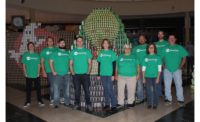Sound Transit University of Washington Station wins Award for Interior Architecture

At the heart of the station, the escalators and glass elevator pass through a 55-foot high underground central chamber, one of the highest interior volumes in the city. LMN Architects and artist Leo Saul Berk collaborated to create an integrated experience for travelers, where the architecture seamlessly merges with Berk’s artwork, "Subterraneum," that expresses the geological layers of soil surrounding the station walls. Photo by Kevin Scott

The 2-level glass entrance structure frames views of the surrounding context, including Lake Washington and the Cascade Mountains. The glass structure also serves as a light well, allowing daylight to reach down to the mezzanine level. Between the surface and the train platform 100 feet below, circulation paths and visual connections between multiple levels orient users to the station’s overall volume, structure and internal flow. Photo by Kevin Scott.


Sound Transit University of Washington Station has received a 2018 National Honor Award for Interior Architecture from the American Institute of Architects (AIA). The UW Station is one of only five projects to be recognized for Interior Architecture this year by the program which “celebrates the most innovative and spectacular interior spaces from across the globe.”
Mark Reddington, FAIA, Partner at LMN says, “We are greatly honored by this recognition. Our design goal for the station was to integrate multi-modal transportation systems anchored by an inspiring public mixing zone that underscores the civic importance of rail transit to the campus community.”
More than a light rail station, the Sound Transit University of Washington Station adds multiple threads to the urban fabric at the intersection of Montlake Boulevard and Pacific Street. Knitting together transportation modalities from bike to bus to pedestrians to trains, the multi-disciplinary design approach creates a unified solution at a previously problematic street intersection, one of the busiest in Seattle, and provides a unique gateway to the UW campus through its above and below-grade experiences.
Design elements throughout the station create a sense of movement and connection with the urban framework. The 2-level glass entrance structure frames views of the surrounding context, including Lake Washington and the Cascade Mountains. The glass structure also serves as a light well, allowing daylight to reach down to the mezzanine level. Between the surface and the train platform 100 feet below, circulation paths and visual connections between multiple levels orient users to the station’s overall volume, structure and internal flow.
At the heart of the station, the escalators and glass elevator pass through a 55-foot high underground central chamber, one of the highest interior volumes in the city. LMN Architects and artist Leo Saul Berk collaborated to create an integrated experience for travelers, where the architecture seamlessly merges with Berk’s artwork, Subterraneum, that expresses the geological layers of soil surrounding the station walls.
The AIA jury noted: “An aesthetically inspiring jewel that doubles as fantastic public art. A very inspired space for the public to engage with on a regular basis. They have made descending deep into the earth pleasant, full of light, color and visual texture.”
Above ground, the station’s new bicycle and pedestrian bridge, with stairs, escalators, and ramps connecting both levels of the entrance structure, curves gently as it spans over Montlake Boulevard to connect with Rainier Vista on the university campus. The bridge plays a critical role in expanding Seattle’s bicycle commuter network, connecting the Burke-Gilman Trail with a new bike lane on the rebuilt State Route 520 floating bridge.
Each element of the project is carefully considered as a component of a larger whole, set within a complex web of uses that encompasses the campus, the surrounding neighborhoods, and important university destinations such as Husky Stadium, the Alaska Airlines Arena, Rainier Vista, and the UW Medical Center. Train passengers can now reach downtown Seattle in six minutes, and SeaTac International Airport in roughly 40 minutes.
“The University of Washington Station beautifully and intricately navigates an almost unbelievably complex urban node,” says Rebecca Barnes, University Architect and Associate Vice Provost for Campus and Capital Planning at the University of Washington. “The outcome is a great architectural and urban design achievement borne of many acts of imaginative and insightful civic leadership.”
The project has received additional recognition from the Chicago Athenaeum, Fast Company magazine, AIA Washington Council, and the AIA Seattle chapter, among others.
Project Team
Architect: LMN Architects
Prime consultant: Northlink Transit Partners: McMillen Jacobs Associates, HNTB and AECOM
Structural engineering consultant: KPFF and AECOM
Mechanical engineering consultant: HNTB
Landscape architect: Swift Company
Architectural technical facilities coordination: Moniz Art & Architecture
Acoustical consultant: The Greenbusch Group
Artist: Leo Saul Berk
Lighting design: Light Wire
Systems design: LTK Engineering Services
Construction management: START
Contractor: Hoffmann Construction Company
Looking for a reprint of this article?
From high-res PDFs to custom plaques, order your copy today!








